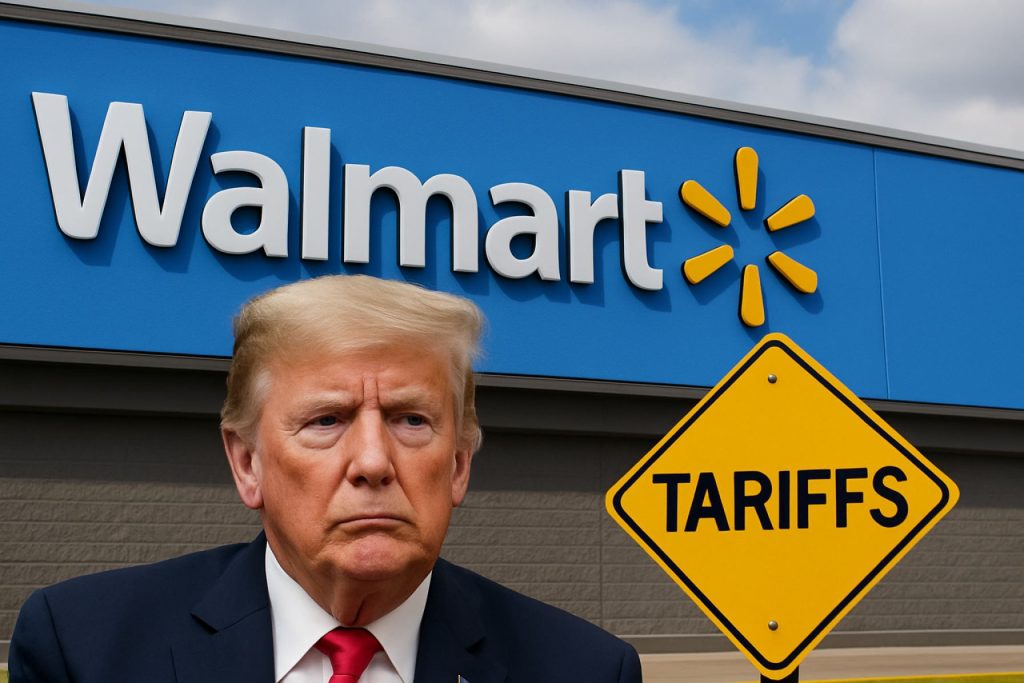
- Walmart faces intense tariff pressures from ongoing U.S.-China trade battles, impacting its ability to maintain low prices.
- Despite record quarterly revenues and a positive outlook, Walmart admits it cannot absorb all cost increases from higher tariffs.
- Shoppers should expect noticeable price hikes by late May and June, affecting not just tariffed goods but items across the store.
- Political leaders debate who should absorb tariff costs, but supply chain complexities mean increased expenses are likely to be passed on to consumers.
- Walmart’s long-standing commitment to affordability faces an unprecedented challenge amid volatile global trade policies.
America’s largest retailer, Walmart, and former President Donald Trump are locked in a very public showdown—one with serious repercussions for the prices that echo through aisles from coast to coast.
It began with a warning, heavy as humid summer air, from within Walmart’s corporate heart. Every day, millions stream through its sliding doors, baskets in hand, seeking refuge from rising costs. Now, even these everyday low prices are under threat.
Trade battles between the U.S. and China have long crackled like distant thunder, but tariffs—new and intense—have finally hit home. Walmart officials recently declared they can no longer shield customers from the storm entirely. “We have always worked to keep our prices as low as possible and we won’t stop,” said spokesperson Joe Pennington. “We’ll keep prices as low as we can for as long as we can given the reality of small retail margins.”
The numbers are staggering: a 2.5% leap in revenue, reaching $165.6 billion in just three months. CEO Doug McMillon, in measured tones during an earnings call, applauded negotiators for progress—acknowledging a temporary ceasefire that slashed tariffs significantly for both sides. Still, these “reduced” rates hover at heights once unthinkable: from 145% down to 30% for some Chinese imports; from 125% to 10% for U.S. goods into China.
Yet reality bites. “We aren’t able to absorb all the pressure given the reality of narrow retail margins,” McMillon admitted. The arithmetic simply doesn’t add up. Chief Financial Officer John David Rainey put it bluntly: “The magnitude of these increases is more than any retailer can absorb.”
- Shoppers are likely to see the pinch at the checkout by late May and June.
- Walmart is forecasting steady sales—$674.5 billion for the year, with $29.5 billion in operating income.
- Experts warn of price hikes not only on tariffed items, but across aisles as Walmart wrestles with cost allocation.
The White House, meanwhile, holds fast to the belief that Chinese producers, not American families, should bear the cost. “Chinese producers will be absorbing the cost of these tariffs,” declared Press Secretary Karoline Leavitt. Trump himself took to Truth Social, thundering, “Walmart made BILLIONS OF DOLLARS last year. Between Walmart and China they should, as is said, ‘EAT THE TARIFFS,’ and not charge valued customers ANYTHING.”
But as Republican Senator Bill Hagerty reminded CNBC listeners, the supply chain is a mosaic of pain points. From distant factories to crowded shipping yards, from the retailer to the kitchen table, “All of them may bear some of that.” Elasticity of demand is the new mantra at Walmart—how much more can shoppers stand before they walk away?
There has been nothing quite like this before. As CFO Rainey explained, “We’ve not seen a period where you’ve had prices go up this high this quickly.” The dance between costs, inventory, and shopper sensitivity grows ever more complicated; Walmart must gauge each item, each region, like a grandmaster chasing victory in a game where the rules keep changing.
As tariff debates rumble on, Walmart’s towering promise—”Save Money. Live Better.”—faces its greatest test. The next time you wheel down the polished aisles beneath those familiar blue signs, remember: the outcome of this standoff could determine, for better or worse, what ends up on your family’s table.
Walmart vs. Tariffs: The Shocking Truth Behind Rising Prices
-
Pros:
Resilience and Scale: Walmart has the leverage to negotiate with suppliers and cushion American families more than smaller retailers during trade wars.
Temporary Relief: Recent negotiations have lowered tariff rates—offering temporary breathing room in pricing, even as underlying costs remain high.
Commitment to Low Prices: Walmart continues to prioritize affordability, striving to keep shelves well-stocked and prices as low as possible despite macroeconomic pressures.
-
Cons & Limitations:
Inevitable Price Hikes: Even Walmart admits not all tariffs can be absorbed; shoppers are likely to see higher prices at checkout as early as June.
Ripple Effect: Tariffs can trigger broader inflation across other aisles and retailers, not just Walmart, as costs get reallocated throughout the supply chain.
Retail Margin Squeeze: Walmart’s famously slim margins are under attack, limiting their ability to act as a buffer for consumers indefinitely.
Demand Sensitivity: There is no precedent for price spikes this sudden; as prices rise, consumers may begin to seek alternatives, challenging Walmart’s dominance.
-
Controversies:
Political Pressure: Prominent figures such as former President Donald Trump publically insist the retailer and China should “EAT THE TARIFFS”—an oversimplification of complex global trade dynamics.
Supply Chain Blame Game: Government representatives and corporate leaders debate over whether Chinese producers or American families ultimately pay, leaving consumers caught in the middle.
5 Bold Predictions: How Walmart’s Price War Will Transform Your Cart by 2025
-
Persistently Higher Prices Are Here to Stay
Experts anticipate that Walmart shoppers will see ongoing price increases as tariff pressures persist and cost allocation grows more complex. Everything from electronics to groceries could experience incremental hikes, reshaping the definition of “everyday low prices.”
-
Supply Chain Strategies Get Smarter
Walmart is expected to double down on advanced logistics, employing more AI-powered inventory management and exploring alternative sourcing to mitigate global tariff impacts. Watch for investments in domestic suppliers and regional fulfillment centers to accelerate.
-
Shopping Patterns Shift as Consumer Tolerance Is Tested
With price elasticity at the forefront, analysts predict shoppers will trade down to store brands and essential goods, possibly avoiding higher-ticket items hit hardest by tariffs. Behavioral shifts may favor budget-friendly innovations and private label products.
-
Political & Trade Policy Will Remain Volatile
The ongoing standoff between figures like the White House and former President Donald Trump will continue to fuel market uncertainty. Policy changes could lead to sudden adjustments in tariffs, forcing Walmart—and its competitors—to react in real time.
-
Walmart’s Influential Role Will Expand Beyond Retail
As America’s largest retailer, Walmart is expected to take a public stance on trade and price issues, aiming to influence both consumer sentiment and government policy. Its initiatives on price communication and transparency will become industry benchmarks by 2025.
The battle over tariffs and prices is just beginning. Whether you’re a loyal Walmart customer or a casual shopper, keep a close eye on these trends—the way you budget, shop, and save in the next few years may look very different than it does today.



